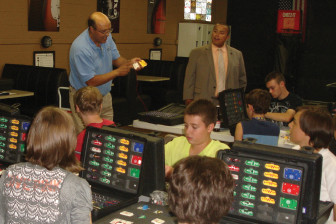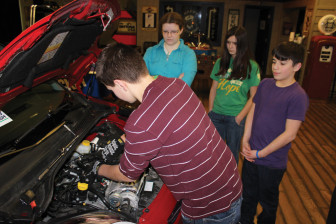
Bridge Teen Center
Chef Gus with Azteca Foods leads a hands-on culinary arts demonstration with teens from The Bridge.
See sidebar “Mentoring Program Wraps from Home to School and Back“
The Bridge Teen Center in the upper-middle-class suburb of Orland Park, Ill., offers after-school and summertime programs aimed at providing recreation and homework help for seventh- through 12th-graders. But many who first encounter the out-of-school-time (OST) center make the mistake of thinking homework and rec is all it does, and some even wonder, given the relative prosperity of the area, why the teen center is needed.
“A lot of people don’t consider [the local youth] at risk: ‘Why do you need a teen center? Our kids are fine,’” mimicked Priscilla Steinmetz, The Bridge’s founder and executive director. “We’ve had to do a lot of advocacy work to help people understand.” Others figure it’s nice to have a place with pool and ping-pong tables but assume that’s all there is to it. “There’s a lot more issues in a student’s life than being able to shoot pool,” Steinmetz said.
In fact, teens who have habitually cut themselves, attempted suicide or become addicted to heroin have attended The Bridge’s programs, said Steinmetz.
“We’ve had students show up on our doorstep who have been kicked out of the house,” she explained. “We work with police and different shelters” to help such youth.
The Bridge Teen Center is among many agencies that have seen greater economic and other needs among its population since the onset of the latest recession and subsequent slow growth in 2010, along with fewer public resources to help fulfill those needs. As much as they can, in whatever creative ways they can, youth agencies around the country have been attempting to either address these needs or refer youth and their families to partners who can.
“We are seen as a holistic agency,” said Kelly Cronin, executive director of Waterbury Youth Service Bureau in Waterbury, Conn., which serves 3,000 youth ages 3 to 21 per year. “We look at the whole family, not just the identified individual who comes into the organization.”

Bridge Teen Center
Community partnerships create unique learning opportunities for students at The Bridge, including this electrical engineering program led by Devry University.
Cronin said her agency has noticed an upsurge in need during the past several years. “One of the clinical agencies in our area has said their caseload has almost doubled,” she explained. The leader of “a family-services agency has said they’ve seen people using their services who wouldn’t have before. People don’t have the resources to get the help they need. Everybody’s been taking a cut. I know that our school department is looking at [tight] budgets.”
With that combination of factors, grassroots agencies play a vital role, Cronin said. “We go into the homes, we out in the streets when the kids are going to school,” she said. “We’re seeing families with dire needs. If they don’t have anywhere to live, what are you wrapping around? People need to have the basics for you to make a difference.”
Danielle Torain, senior associate at the Annie E. Casey Foundation, sees potential for youth-service agencies to make a difference in areas they might not have considered previously through collaboration and wraparound services. “There’s no need out there that can’t be met,” she said. “It’s a matter of building the right networks, so you’re able to access the right support at the right time.”
Torain administers local grants in Casey’s hometown of Baltimore aimed at summertime youth programming, and she said youth agencies are culturally well equipped to ride the ebb and flow of the funding landscape while building wraparound services. “They maintain on a shoestring budget; they’re very used to that type of climate,” Torain said. “They’re very scrappy when it comes to partnering and collaboration. They’re getting more and more so because [funding] is never guaranteed. Their bottom line is making sure services are available for kids.”
Casey has partnered with the Harry and Jeannette Weinberg Foundation around training and capacity building for youth-focused organizations to leverage their fellow grantees as a summer service provision network, Torain said.
“We get a lot of information from those [training and capacity-building] workshops,” Torain explained. “We’re trying to think about our sets of grantees and their needs holistically,” so they can learn from one another and potentially help one another think through their common issues or build better relationships.
Torain pointed out the Incentive Mentoring Program (IMP) in Baltimore, which receives funding from Casey and is regarded as a “high performing program” locally. IMP provides wraparound services for youth and their families and sees itself as an extension of family, according to founder Sarah Hemminger.
“We are a one-stop shop,” she said.
IMP takes referrals from two local high schools (soon to be three) among students whose GPA is at the 25th percentile or lower, then selects those with the highest level of other challenges such as homelessness, foster care, poverty, mental illness or drug addiction. “We basically select the kids who have the most challenges outside of school that are impacting their personal education outcomes,” Hemminger said. “Once they’re enrolled, we stay with them for a decade.” (For more on IMP, please see sidebar.)
The Bridge to wraparound

Bridge Teen Center
Students look under the hood of a car while they learn to change their own oil at a program sponsored by a local Fiat dealer.
The Bridge Teen Center has gradually built a suite of holistic, wraparound services that attract more than 250 teens (and some parents and families) each week during the school year, and closer to 350 to 400 during the summer. The Bridge has welcomed more than 2,600 students with a total of more than 20,000 visits in its four years of existence, Steinmetz said, offering programs to help parents navigate through the teen years, an annual financial-aid clinic for high school seniors, referrals to resources like food pantries and addiction centers, and talks by medical professionals about everything from fitness, to stress and sex education, Hemminger said.
“A lot of parents see us as a resource,” she says. “When something happens, we get a phone call. We are not necessarily a crisis center.
[But] we’re able to point them in a direction where we’re able to get additional help. We do follow up with them to make sure they don’t feel alone.”For example, a local chain grocery called The Bridge to report that a new employee was a homeless teenager who lived in a different friend’s house every month. “We have a whole packet of information on where to get food, shelter and other ways to [help him] get up on his feet,” Steinmetz said. “We are not a food pantry, we’re not a clothing place, but we have these resources. We have developed these relationships [based on the teens’ needs].”
The Bridge has methodically mapped out resources and checked back annually to make sure that potential referral sources are still where they were last year. Internally, Steinmetz and her staff have worked intentionally to train volunteers and make sure policies are well communicated.
Going holistic in Waterbury
The Waterbury Youth Service Bureau — one of about 100 geographically based Youth Service Bureaus throughout Connecticut and one of a handful that are nonprofits rather than units of local government — has always provided holistic services that go beyond OST recreation and homework help, said Cronin. But the agency has stepped up its efforts in the past six months thanks to a $20,000 grant from the local Leavonworth Foundation that includes money for tutoring in addition to meeting youths’ basic needs.
“It’s more formalized at this point. We were never able to get basic needs from grants. To have basic needs-specific funding is new to us,” Cronin said. “I’ve been singing this song forever: ‘Kids can’t better themselves if they don’t have their basic needs met.’ Do they need clothes to go to school? Do they need food on the table? Does mom need money to go to work?’ ”
“The end of the month is very difficult for most of our families — food stamps have run out,” Cronin added. Yet families hesitate to ask for help. “That takes a lot of work, that they feel comfortable to [seek help]. These families are very proud. To ask for a handout isn’t easy for any of them.”
Cronin recalls one young man whose mother had been able to give him money for a prom ticket, but he didn’t have funds to rent a tuxedo. Waterbury Youth helped him buy a suit rather than rent a tux because he was an aspiring artist who might have other uses for the suit. “What did that mean to him?” reflected Cronin. “Probably everything.”
See sidebar “Mentoring Program Wraps from Home to School and Back“






























